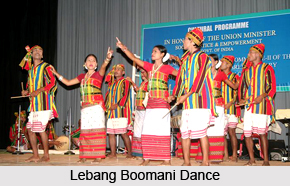 Lebang Boomani Dance is also known as `Lebang Bumani` and is an interesting harvest dance-form which is practised by the regional inhabitants of the north-eastern Indian state of Tripura. This dance is amongst the two dances which are connected to the people of Tripura, and the other dance is called the `Garia Dance` performed during sowing the crops. Soon after Garia, the residents of Tripura eagerly wait for the arrival of the monsoons which fuels enhanced agricultural activity in the hills. Colourful insects termed as `lebangs` approach the hillsides in hordes seeking the sown seeds. The dance movements of Lebang Boomani dancers portray the procedure of catching these tiny insects with the aide of bamboo clappers. Tripuris are of the view that more the number of lebang insects caught by them, the greater the chances of a prosperous harvest it would imply.
Lebang Boomani Dance is also known as `Lebang Bumani` and is an interesting harvest dance-form which is practised by the regional inhabitants of the north-eastern Indian state of Tripura. This dance is amongst the two dances which are connected to the people of Tripura, and the other dance is called the `Garia Dance` performed during sowing the crops. Soon after Garia, the residents of Tripura eagerly wait for the arrival of the monsoons which fuels enhanced agricultural activity in the hills. Colourful insects termed as `lebangs` approach the hillsides in hordes seeking the sown seeds. The dance movements of Lebang Boomani dancers portray the procedure of catching these tiny insects with the aide of bamboo clappers. Tripuris are of the view that more the number of lebang insects caught by them, the greater the chances of a prosperous harvest it would imply.
Women as well as menfolk participate in the Lebang Boomani dance and bamboo clappers known as `tokkas` are employed by the men for maintaining the general rhythm of the dance. The women wave attractive scarves to grab the attention of the lebang insects out from their hideouts, thereby allowing men to catch hold of them. Musical Instruments including Khamb, Flute, Sarinda and `Pungi` which is an important percussion instrument are all played during the Lebang Boomani performance. The women dancers beautify themselves with bangles; nose rings, silver chains and ear ring composed of bronze and therefore look beautiful while they practise this dance. Flowers are also worn by the women as jewels for adorning themselves prior to the dance performance. Today, with time jhuming on hill slopes is gradually diminishing from this part. But the cultural life that developed around the Jhum has delved deep into the social life of these people, since most of the state`s population on the hill slopes, practise it.
This article is a stub. You can enrich by adding more information to it. Send your Write Up to content@indianetzone.com



















